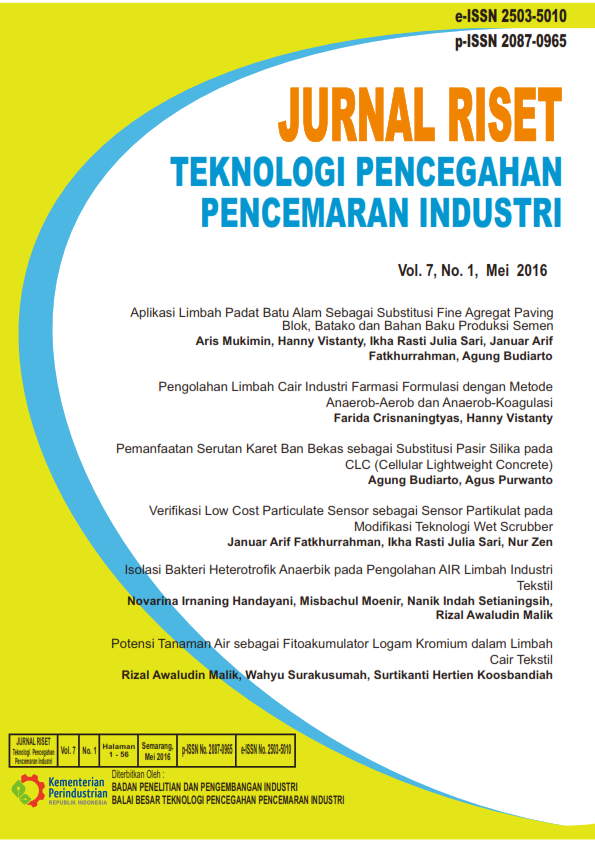APLIKASI LIMBAH PADAT BATU ALAM SEBAGAI SUBTITUSI FINE AGREGAT PAVING BLOK, BATAKO DAN BAHAN BAKU PRODUKSI SEMEN
DOI:
https://doi.org/10.21771/jrtppi.2016.v7.no1.p1-12Keywords:
Batu alam, paving blok, batako, semenAbstract
Pemanfaatan limbah padat batu alam menjadi penting dilakukan supaya keseimbangan lingkungan dapat dijaga dan dapat berpeluang menjadi sumber usaha baru yang akan berdampak pada sektor ekonomi masyarakat sekitar. Lokasi pengambilan limbah padat ditetapkan dari salah satu industri pengolahan batu alam di Kabupaten Cirebon. Sumber limbah tersebut berasal dari serbuk padat hasil pemotongan dan sludge hasil sedimentasi. Jenis batu alam yang menjadi obyek penelitian terdiri dari dua, yaitu batuan andesit dan batuan Palimanan. Produk bahan bangunan yang dibuat dari limbah padat batu alam hanya dua, yaitu paving dan batako, dimana dalam hal ini limbah difungsikan sebagai subtitusi fine agregat. Pemanfaatan limbah sebagai bahan baku hanya dipelajari dan diaplikasikan untuk pembuatan semen. Limbah padat batu alam dapat digunakan sebagai subtitusi fine agregat dalam pembuatan paving dan batako. Persen subtitusi limbah padat batu alam untuk paving mencapai 30% untuk Andesit dan 50% untuk palimanan dengan kualitas B, C dan D. Persen subtitusi limbah padat batu alam untuk batako mencapai 50% untuk Andesit dan Palimanan dengan kualitas I, II, III dan IV. Limbah padat batuan Palimanan mempunyai image permukaan yang lebih kasar dibanding Andesit. Kandungan utama limbah padat batuan andesit sama dengan palimanan, yaitu: karbon, silika, alumina, kalsium oksida dan besi oksida. Limbah padat batu alam dapat dimanfaatkan untuk membuat semen dengan persen komposisi antara limbah dengan kapur sebesar 43%:56% dan dipanaskan pada suhu 800 oC selama 2 jam dilanjutkan ke 1450 oC selama 3 jam.References
Allam ME., Bakhoum ES., Garas GL., 2014, Re-use of Granite Sludge in Produccing Green Concrete, Journal of Engineering and Applied Sciences 9 (12); 2731-2737
Almeida N., Branco F., Brito J., 2007, High-performance concrete with recycled stone slurry, Cement and Concrete Research 37; 210–220
Almeida NM., Branco F., Santos JR., 2005, Recycling of stone slurry in industrial activities: application to concrete mixtures, building and environment 42; 810-819
Alzboon KK., dan Mahasneh KN., 2009, Effect of Using Cutting Stone Waste on the Compression Strength and Slump Characteristics of Concrete, Int. J. Env. Chem. Eco. Geo. Eng 3 (3) 83-88
Balasubramanian J., Sabumon C., Lazar JU., dan Ilangovan R., 1995, Reuse of textile effluent treatment plant sludge in building materials, journal of materials processing technology 48 (1-4) : 379–384.
Colombo A., Tunesi A., Barberini V., Galimberti L., Cavallo A., 2008, Chemical and mineralogical characterization of cutting process sludge ,exploitation of sludge from stone working synthesis of the research.,accessed 2008,http://www.aigt.ch/ download/ rapporto_INTERREGen.pdf.
Ferreira JMF., Torres PMC., Silva MS., and Labrincha JA., 2004, Recycling of granite sludge in brick-type and floor tile-type ceramic formulation. Journal of the European Ceramic Society 24 (10-11): 3177-3185.
Kuswah RS., 2015, Utilization Of “Marble Slurry” In Cement Concrete Replacing Fine Agreegate. American Journal of Engineering Research 4 (1);55-58
Munoz-Muntano J., 2003, Project Reference BRST985531, Recycling of waste originated in the process of cutting natural stone, In: BRITE/EURAM3
Nemerow, Nelson L., 2009, Environmentl Engineering, Sixth Edition : Environmental Health And Safety For Municipal Infrastructure, Land Use And Planning, And Industry. John Wiley & Sons. Hal.50
Neville AM., 1982, Properties of Concrete, Pini, SP, Brazil
Turgut P., dan Algin HM., 2007, Limestone dust and wood sawdust as brick material. Building and Environment Journal 42 (9): 3399-3403
Torres P., Fernandes HR., Agathopoulos S., Tulyaganov DU., and Ferreira JMF., 2004, Incorporation of granite cutting sludge in industrial porcelain tile formulations, Journal of the European Ceramic Society 24 (10-11):3177-3185.
Uchikawa H., Hanehara S., Hirao H., 1996, Influence of microstructure on the physical properties of concrete prepared by substituting mineral powder for part of fine aggregate,Cement andConcreteResearch 26 (1); 101–111.
Weng C., Lin D., dan Chiang P., 2003, Utilization of sludge as brick materials. Advances in Environmental Research, 7 (3): 679-68
Downloads
Published
How to Cite
Issue
Section
License
Copyright (c) 2020 Aris Mukimin, Hanny Vistanty, Ikha Rasti Juliasari, Januar Arif Fatkhurrahman, Agung Budiarto

This work is licensed under a Creative Commons Attribution-NonCommercial-ShareAlike 4.0 International License.











